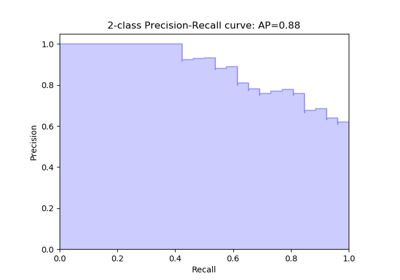sklearn.metrics.precision_recall_curve¶
-
sklearn.metrics.precision_recall_curve(y_true, probas_pred, pos_label=None, sample_weight=None)[source]¶ Compute precision-recall pairs for different probability thresholds
Note: this implementation is restricted to the binary classification task.
The precision is the ratio
tp / (tp + fp)wheretpis the number of true positives andfpthe number of false positives. The precision is intuitively the ability of the classifier not to label as positive a sample that is negative.The recall is the ratio
tp / (tp + fn)wheretpis the number of true positives andfnthe number of false negatives. The recall is intuitively the ability of the classifier to find all the positive samples.The last precision and recall values are 1. and 0. respectively and do not have a corresponding threshold. This ensures that the graph starts on the y axis.
Read more in the User Guide.
Parameters: - y_true : array, shape = [n_samples]
True binary labels. If labels are not either {-1, 1} or {0, 1}, then pos_label should be explicitly given.
- probas_pred : array, shape = [n_samples]
Estimated probabilities or decision function.
- pos_label : int or str, default=None
The label of the positive class. When
pos_label=None, if y_true is in {-1, 1} or {0, 1},pos_labelis set to 1, otherwise an error will be raised.- sample_weight : array-like of shape = [n_samples], optional
Sample weights.
Returns: - precision : array, shape = [n_thresholds + 1]
Precision values such that element i is the precision of predictions with score >= thresholds[i] and the last element is 1.
- recall : array, shape = [n_thresholds + 1]
Decreasing recall values such that element i is the recall of predictions with score >= thresholds[i] and the last element is 0.
- thresholds : array, shape = [n_thresholds <= len(np.unique(probas_pred))]
Increasing thresholds on the decision function used to compute precision and recall.
See also
average_precision_score- Compute average precision from prediction scores
roc_curve- Compute Receiver operating characteristic (ROC) curve
Examples
>>> import numpy as np >>> from sklearn.metrics import precision_recall_curve >>> y_true = np.array([0, 0, 1, 1]) >>> y_scores = np.array([0.1, 0.4, 0.35, 0.8]) >>> precision, recall, thresholds = precision_recall_curve( ... y_true, y_scores) >>> precision array([0.66666667, 0.5 , 1. , 1. ]) >>> recall array([1. , 0.5, 0.5, 0. ]) >>> thresholds array([0.35, 0.4 , 0.8 ])


